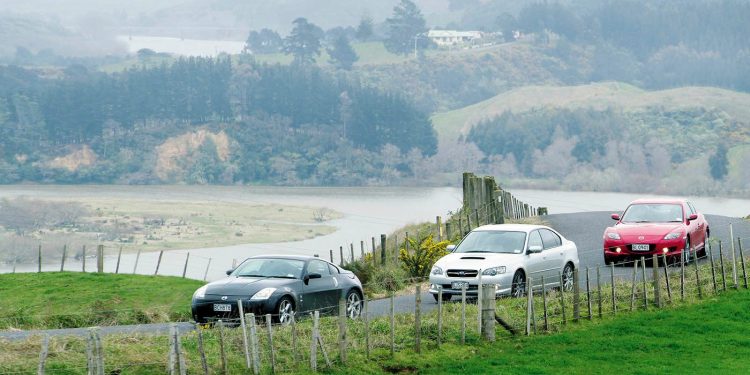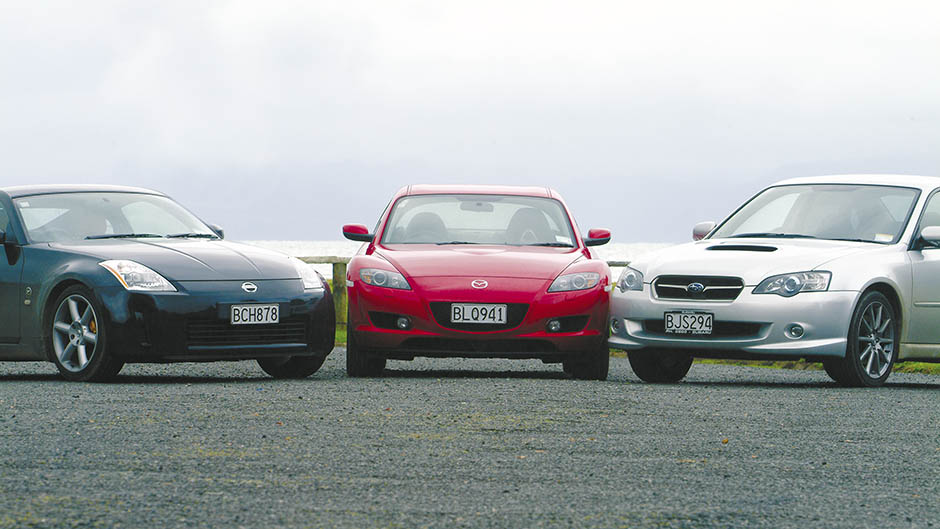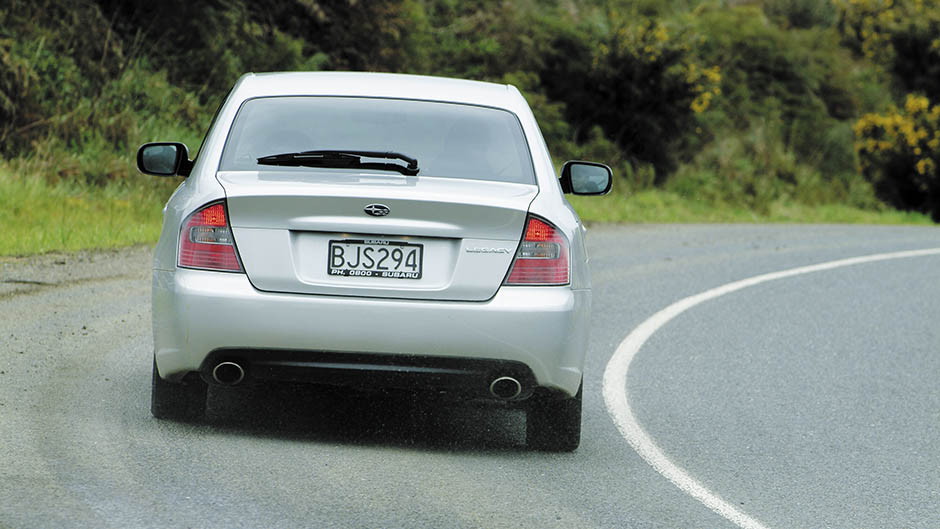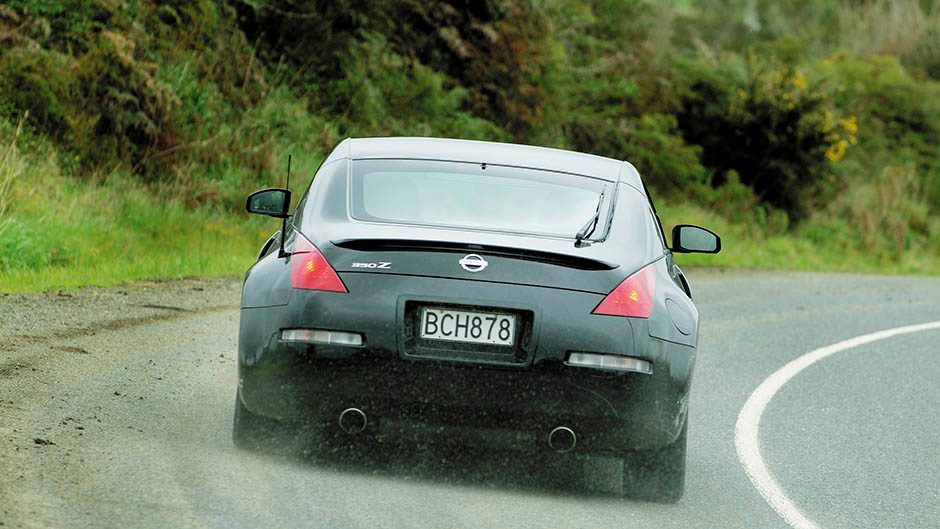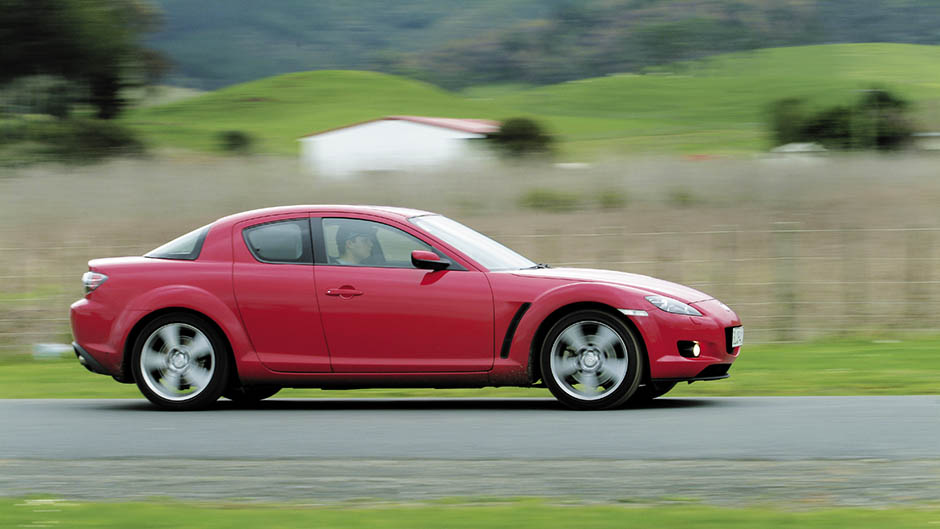2003 Mazda RX-8 vs Nissan 350z vs Subaru Legacy GT comparison
Words Peter Louisson | Photos Tom Gasnier/Adrian Payne
Eagerly awaited sports icons, the RX-8, 350z and Legacy GT, are finally assembled for a performance free-for-all. After driving all three hard, it’s almost too close to call…
Sometimes decision making for motoring writers comes easy, but other times it feels like a high-wire balancing act, with no safety net below. Imagine comparing three vehicles, all of which are not only potential performance cars of the year but are also Car of the Year contenders. Too much pressure!
Unfortunately, this is where we find ourselves, comparing the Nissan 350Z, the Mazda RX-8 and the Subaru Legacy GT. Why these three cars? They have similar power-to-weight ratios (all seven point something), and each has a serious sporting persona. They are also reasonably close in price, the range between least and most expensive being just $8K. It seems almost immaterial that one is a two-seater, another a four-seater four-door 2+2 coupé (huh?), and the final contender obstensibly common or garden four-door sedan. Fundamentally, these cars will appeal to a similar buyer, albeit with slightly different needs.
Do we actually pick a winner here? That would be telling – read on. We decided to include four other opinions because it seemed unfair to leave such a close call up to one individual. We invited each of the road test crew to drive these cars and justify their choice (see end of feature). So, a democratic call.
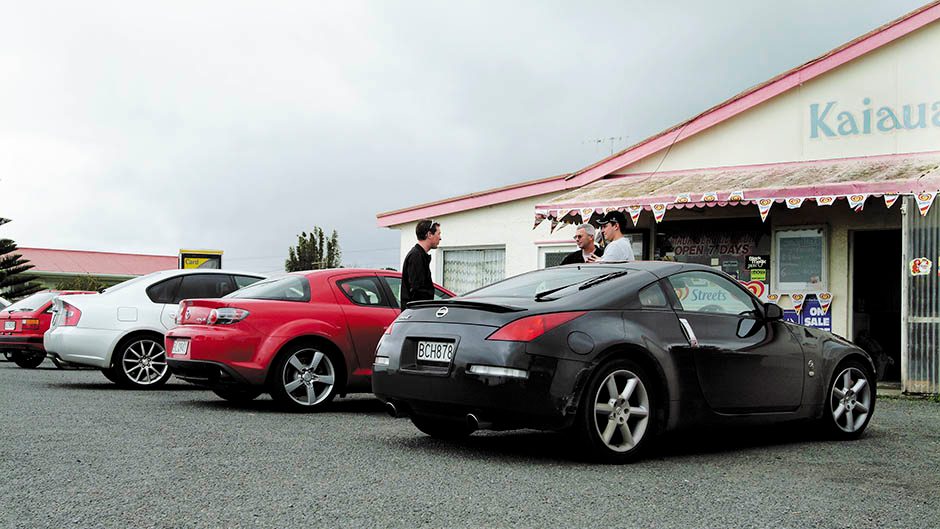
What we can say for sure is that there is no loser here – they’re all five-star vehicles and COTY contenders. We know this for sure because one of the manufacturers has publicly stated it as fact!
While the decision time was agonising, one thing was clear. It was the best driving week we had all year.
Price/Equipment:
Only one of the trio, the Sub, has an RRP starting with a ‘5’, though it may as well be a ‘6’, given you net $10 change from $60,000. The GT is the only turbo of the group, and it’s the only one with all-wheel drive, five seats and a family-friendly boot. However, it’s also the only one with a five-speed gearbox; the others get six-shifters. A five-speed Sportshift automatic option is available for $63K.
My boys and I were absolutely blown away by the McIntosh sound system in the GT. The kids reckon they’ve never heard Eminem sound so ‘bad’. The RX-8 also boasts impressive audio with a modern, CD-shaped, ‘piano-black’ face. Not quite the hi-fi look – the Macca has an aluminium faceplate – but serious bass impact. The Bose system in the Zed is also a kicker, with its separate dedicated subwoofer, but the head-unit is less flashy.
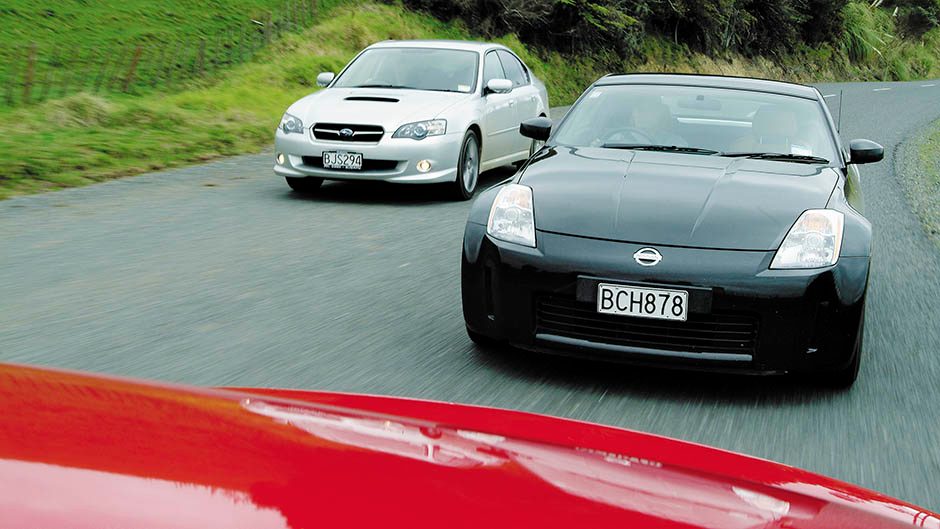
The Legacy GT features a comprehensive list of gear, missing only cruise control: there are heated leather seats with power adjustment, back-lit instruments, trip computer and active head restraints. Only dual airbags, however – Subaru concentrates on the active safety of 4WD.
RX-8 is the only rotary in the group, naturally. It retails for $62K, whether in six-manual or four-auto mode, and the price includes free servicing for three years. It undercuts the six-speed manual Track option of the Nissan 350Z by $6000. Specification runs to six airbags, leather trim, power seat-adjust, stability and traction control systems, Xenon headlamps, climate air, and cruise and audio controls on the wheel.
Nissan’s 350Z Track is the only one of the three to get different-sized rubber fore and aft – and plenty of it: 225/45 R18 front and 245/45 R18 rear. Specification levels in the Nissan are otherwise incredibly similar to those of the Mazda – or perhaps that should be the other way around, given the RX-8 came along later!
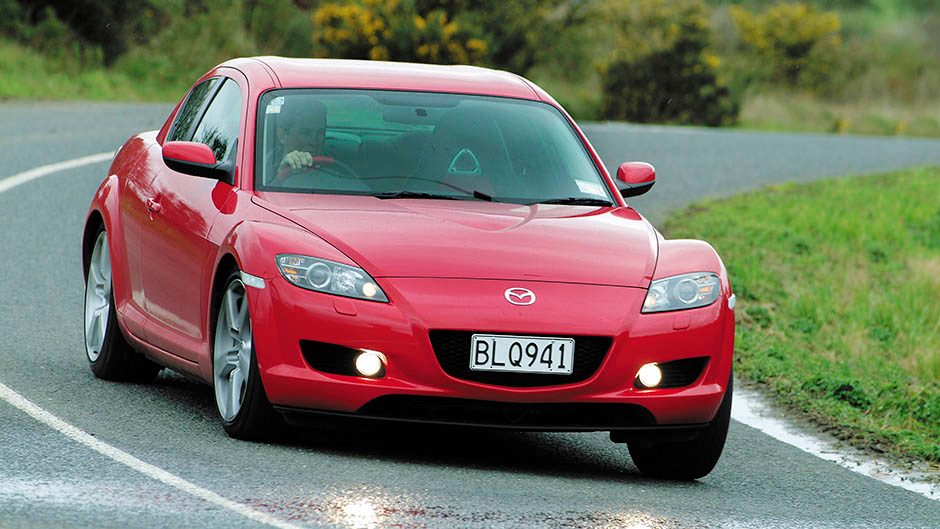
Design/Engineering:
RX-8 highlights are its Renesis engine, which won the International Engine of the Year award recently, and its barn-style centre opening doors.
A recent news report suggested that US versions of the RX-8 rotary engine are underpowered by five per cent. Mazda NZ staff assure us local RX-8s create all their 177 claimed kilowatts. Which still makes it the most anaemic offering here, producing only 58 per cent of the 350Z’s torque figure.
Mazda aims quite simply for RX-8 to have class-leading ride, handling, steering and braking. And for COTY status.
The Legacy is now into its third generation and is almost all new. Engineers aimed to make it lighter (it weighs over 50kg less) and quieter (it has a Cd ratio of 0.28, and recorded the lowest dB reading), so mission accomplished. Changes to the sheet metal might be minor, but they are significant – it’s more aggressive, but at the same time sleek, with Germanic lines – check the A4-like profile.
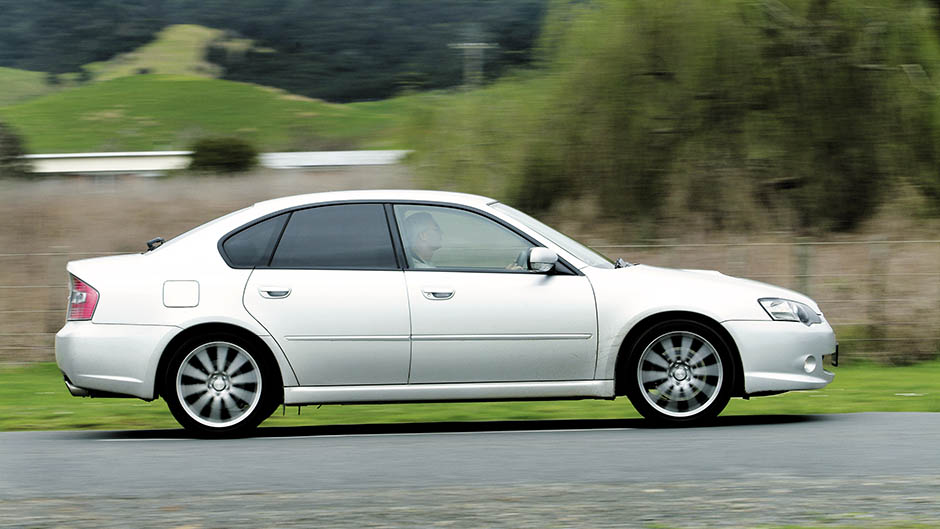
The advertising centres on the new titanium twin-scroll turbocharger, ironically supplied by Mitsubishi. Output figures are unchanged at 206kW/343Nm, but peak torque is produced at 2400rpm instead of 5000rpm. Responsiveness supposedly improves by 40 per cent, aided by new drive-by-wire throttle activation and the adoption of variable valve timing. New headers and exhaust system make for a more meaningful Boxer sound.
Other engineering changes of note include brake, suspension and steering upgrades, and a minor reshuffle of the engine location. It now sits 22mm lower up front, and the rear is down by 10mm, creating a lower centre of gravity for improved handling.
The 350Z has heritage that dates back to the 240Z first launched in 1969. In 2001 a new Zed concept broke cover, and the production version 350Z launched in the US last year. Nissan has followed Mazda down the 50:50 front to rear weight-balance pathway. Its other critical design feature is chassis rigidity. There’s a double-layer floor, and front and rear strut tower braces. Like both the other cars, suspension links are aluminium, and the prop shaft is carbon fibre, like the Mazda’s. Nimble flat handling was also a priority.
The power source of the 350 is, naturally, a 3.5 litre V6 with variable valve timing and an identical power output to the Subaru. While its torque peak is higher, at 363Nm, it is also achieved at exactly twice the revs of the GT. It is mated to a six-speed tranny, with fifth gear direct, sixth overdriven.
Without further ado, it’s time to get out the stopwatch, er, VBOX, in this magazine’s case.
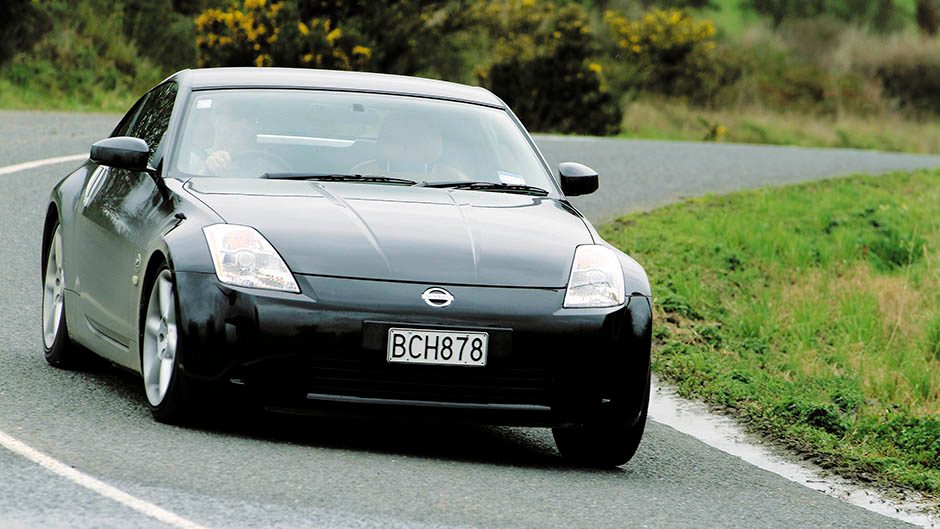
Performance:
It’s the family sedan that gets the better of the sportsters here, thanks to forced induction and a five-speed gearbox. The Legacy GT flat-out annihilates the old RSK B4, flashing to 100km/h in 5.57 seconds. The others weren’t in the 0-100 hunt because they couldn’t make it in second gear. The 350Z managed a 6.24s pass, and the RX-8 6.75s. When you examine overtaking (TED) times, the Zed car and Legacy are all but identical (3.76 vs 3.77s), and the RX-8’s relative torque deficit becomes apparent. TED took 4.9 seconds.
Paradoxically, the Legacy is the slug of the group. It’s speedo ends at a responsible 180, and it hits the speed limiter so hard in fourth gear, it’s like running into quicksand.
Mazda reckons that the RX-8 will repeatedly achieve 100-0 in 36 metres. We reckon that’s absolute rubbish because we managed a best stoppie of 33.39m, and it consistently beat 35m in subsequent efforts. Which makes the RX-8 the second-best stopper we have ever tested. Its pedal action is the best here, and the way the brakes kill speed with just a whiff of pressure contributes to this car feeling the most controllable of the trio. The Nissan is next best, managing 34.63m, but you have to lean on the pedal more. The Legacy brakes disappointed, with a best panic stop from 100 taking 38m, but they feel better than this, and don’t lack for power.
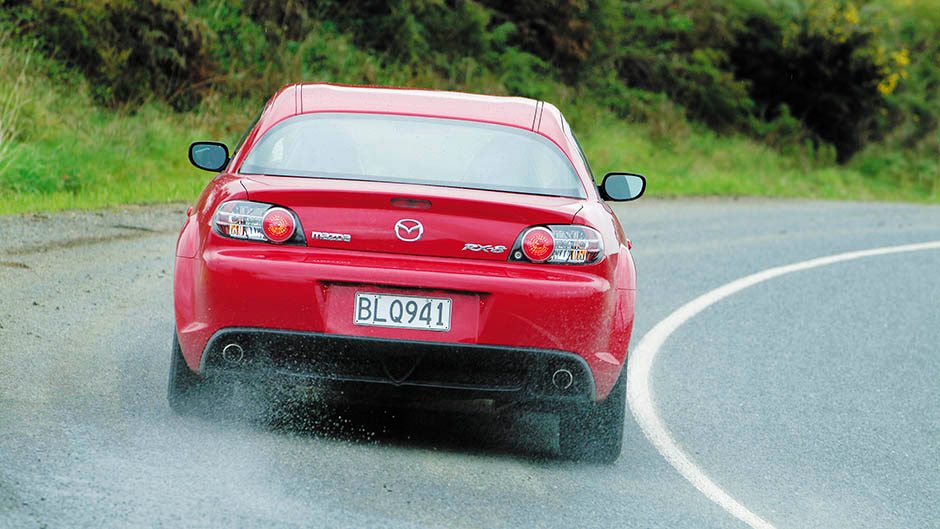
How do the motors compare? The Nissan’s flood of torque, 300Nm by 2000rpm, makes it easy to maintain a high average speed. While it has a rough and gruff nature, and snarls menacingly when you press the throttle, the engine doesn’t have quite the same individual character of the others. After driving the RX-8, you get to the rev limiter at 6600 in the Zed and wonder where the rest of the revs went. The V6 has the potential to be the most economical of the three, but it’s such a hoon of a car that you find yourself caning it everywhere and draining the tank too quickly. None of these would find itself on the Green Party must-have list of eco-friendly vehicles.
Back in the RX-8 and it’s much more hushed than the Zed, and controls are much lighter. Another stubby little gear lever too, and in both it’s a sheer pleasure shifting from cog to cog as the need arises, or as the mood takes you. The RX-8 engine is simply a mind-warp. Some reckon it lacks torque, and yet at urban speeds the merest whiff of throttle at 2000rpm has it leaping forward. You can keep abreast of others using just 2000 to 3000rpm around city streets. And the motor is unbelievably smooth in a way only rotor-motion can be.
Once you’ve broken free of the shackles of suburbia, the ‘other’ side of the engine beckons, the side that says fun begins at precisely 7200rpm. From there, in a trice, the warning bells are ringing at 9000, and you’re into the next cog. It’s so quick to rev, even in the upper gears. While the band may seem narrow, it’s ready to rock from 6000rpm, so you’ve over 3000rpm kick-ass revs with which to play. It reminds of the Civic type R mill, except for the evocative rasp. A check on the rev counter at 110km/h and it reads off a neat 3500, just over one-third of potential revs. We felt but couldn’t confirm (no trip computer) that fuel efficiency is acceptable, providing you’re not always redlining it. However, it’s probably the thirstiest 1300 you’ll ever encounter. Not that the Legacy’s exactly a miser. We consistently got 5.5km/L, or 18L/100km. Ouch. Zed fared better, managing 13.5L/100km driven in our usual take-no-prisoners manner. Figure on these being pessimistic.
Out of the others and into the Legacy GT, you immediately notice the turbo lag, and you just as soon dismiss it by anticipation. This is a midrange monster. There is so much going on between 2500 and 5000 that we seldom needed to use higher revs on our usual test loop. Over quiet roads, you can hear the waste gate purge when you shift up a gear, just like STi. The gearbox is the least impressive of the three, with the longest throw and the most meshing. A pity it doesn’t get the six-shifter of the STi. It is, however, the quietest of the three cars. Road roar seems worst in the Mazda, which is confirmed by readings of sound pressure levels.
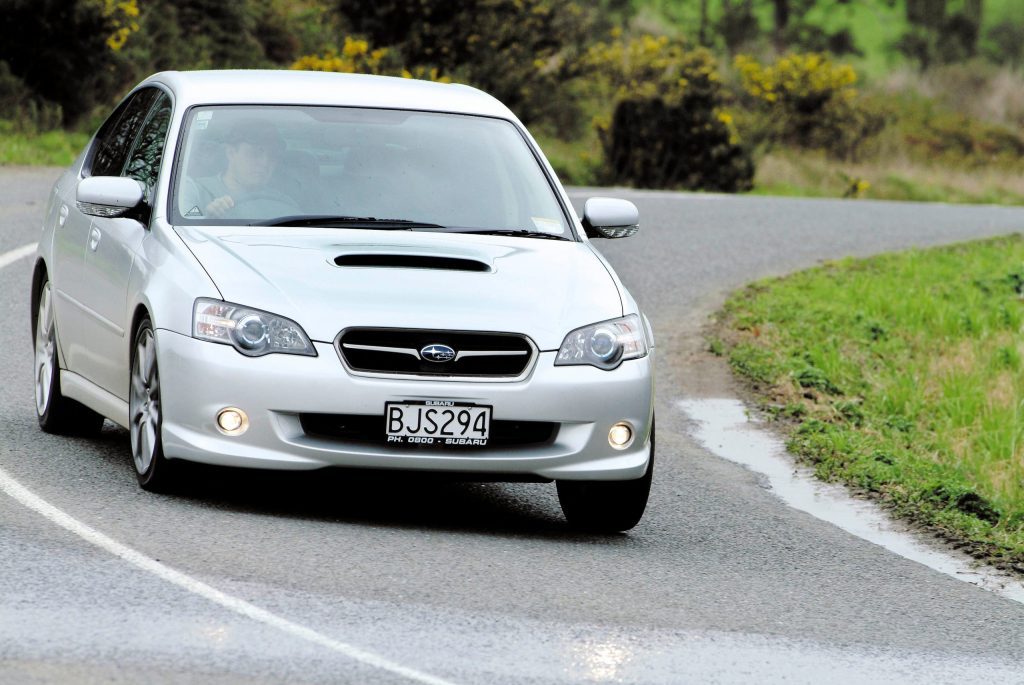
Driving Dynamics:
Each is brilliant to drive hard and fast, but for different reasons. The least fun, in some ways, is the Legacy GT, and yet it is arguably the most competent. Herein is the dilemma. Its prodigious grip makes it seem clinical, though it is the safest when road/weather conditions are anything other than perfect which, in NZ, is one in four days. Its chassis strength and integrity are never in question, and with the relatively minor changes to steering, centre of gravity and roll centres, the Legacy steps up a whole ’nother level over the RSK. When push comes to shove it just doesn’t waver. As you explore its considerable limits, the tail starts to shuffle sideways rather than leaning and unloading in the rear like the Impreza. Its steering is luscious, much more direct than before, with urgent initial turn-in, and the lightest weighting of the three. For feedback, it treads a halfway house between the other two. The long travel suspension soaks up all but the worst we could throw at it, though passengers might complain at slow speeds of fidgety ride quality that seems related to the firm Bilsteins dampers. It gets the hard, fast and heavy action so right, that we forgive it this minor indiscretion.
We absolutely loved driving the 350Z full bore, while at slower speeds its ride, too, is a touch edgy. But its limits are just astounding, its chassis dynamics unflappable. It has more grip than the RX-8, and its suspension takes the big hits at speed better. It’s also more grounded when high flying, where the Mazda wanders a little. And the steering is a joy – communicative, and with some kickback, but not enough to be a distraction. It’s weighty too, in a sporty way.
And if I have any misgiving about the Zed it is that it feels a touch overweight, making it slightly harder to place on road, and more demanding of concentration than the RX-8. The Mazda gets the ride/handling mix almost perfect for our difficult roads, and while its electric steering isn’t quite as chatty as the 350’s, it makes up with a lightweight, communicative chassis that’s easier to flick into turns, and more willing to change direction. It also feels more compact and lithe than do the others. It power-slides with uncanny precision, like it was built for it. While its suspension might not take the big hits the others shrug off, the ride supremacy at slow speeds is readily apparent.
The RX-8 reminds me distinctly of when I first discovered the delights of a lightweight rear-drive sports car, of the time I first drove the MX-5 hell for leather. It offers an alternative to MX-5 owners grumbling about power and practicality. While the RX-8 may not be as pure as the smaller car, you know it’s from the same company.
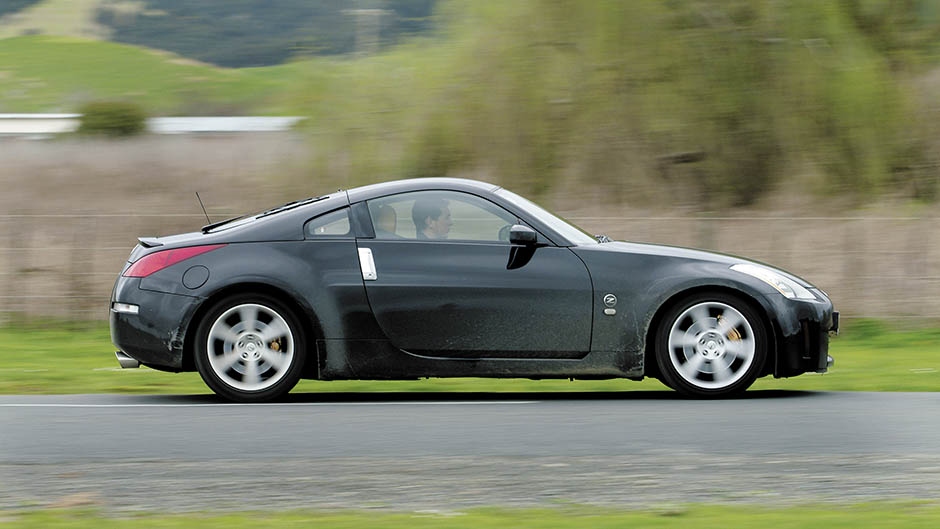
Comfort/Convenience:
The Zed loses a half point here for its pods, of which there are but two. The interior design pales somewhat against the RX-8; it looks to have been finished to budget. It hasn’t the snap, the dazzle or the sheer craftsmanship of the Mazda. However, we did like the fact that the instruments move with the steering column, and that it has both analogue and digital speed readouts. The heated seats are a thoughtful feature, shared by Legacy, which has a plainer interior but is a step up on the RSK. Seats in the Mazda suited me best, followed by the GT’s. The Nissan units are easily adjustable but the edges seem to dig in rather pointedly. Zed 350 pedals are well positioned for heel and toeing, better than those in the RX-8, which are also offset to the right.
The Mazda’s so-called freestyle doors are ingenious, though first popped up on Ford/Mazda workhorses like F150 and Bounty. That they offer traditional four-door ingress for rear passengers is enough, but they are said to offer excellent protection in side impacts as well. And the seatbelt is easily reached by the driver, more so than in two-door sportsters. Space in the rear of the RX-8 is a little claustrophobic, but shorter adults and kids will enjoy their journeys. The luggage space is much improved without the space-saver spare, but the opening is mean. Both the 350 and RX-8 tote two sets of golf clubs, but only about half of what the Legacy can stow.
Our 50 words’ worth
Peter Louisson
The RX-8 gets my vote. Its heady mix of light weight, rear-drive handling, compliant ride, innovation and rotary pizzazz stole my heart. There’s rumour of a supercharged version!
Mark Petch
If I had to make a choice, I would take the Q-ship Subaru, though my heart would yearn for the 350Z, as it’s the only true bad-ass sportscar here. Give the RX-8 more torque, and the refinement of its chassis would ring my bell too.
Adrian Payne
The 350Z is the babe of the bunch, and it feels commanding on fast, flowing roads. Subaru’s flagship GT offers massive grip, and torque-laden acceleration. But I’d choose the RX-8 for its fine balance and handling, and the buzz of the rotary.
Kyle Cassidy
Three amazing cars, all mile-munchers. The Subaru is quickest, with awesome drive off the corners, RX-8 thrives on revs and the chassis is magic, but I found the Zed the most involving. It’s a no-compromise sports car that carves up B-roads like few others can.
Paul Owen
I’d love to own any of these three cars, but if forced to choose one for entirely selfish reasons, I’d take the 350Z. It’s the exterior design that’d make me go for the Nissan – it’s completely demolished all my Porsche 911 fantasies. That it’s the most focused car of the trio is a bonus.
| Model | Mazda RX-8 |
| Price | $61,995 |
| Engine | 1308cc, rotary, EFI, 177kW/211Nm |
| Drivetrain | e-CVT, front-wheel drive |
| Fuel Use | 6-speed manual, rear-wheel drive |
| C02 Output | N.A. g/km |
| 0-100km/h | 6.75sec |
| Weight | 1355kg |
| Model | 2003 Nissan 350Z |
| Price | $64,990 |
| Engine | 3498cc, V6, EFI, 206kW/363Nm |
| Drivetrain | 6-speed manual, rear-wheel drive |
| Fuel Use | 11.5L/100km |
| C02 Output | N.A. g/km |
| 0-100km/h | 6.24sec |
| Weight | 1495kg |
| Model | 2003 Subaru Legacy GT |
| Price | $59,990 |
| Engine | 1994cc, flat 4, T/EFI, 206kW/343Nm |
| Drivetrain | 5-speed manual, all-wheel drive |
| Fuel Use | N.A. L/100km |
| C02 Output | 12.0g/km |
| 0-100km/h | 5.57sec |
| Weight | 1468kg |


